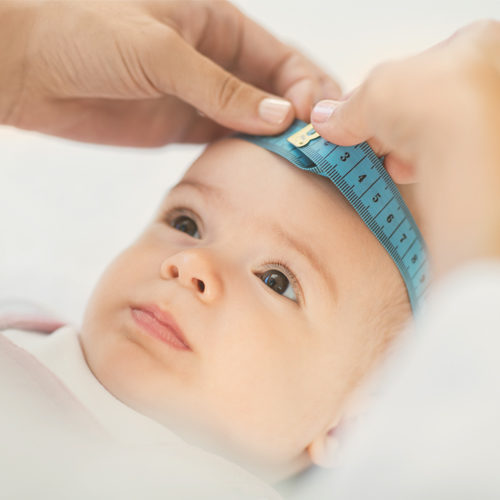Your Child’s head circumference
The head size indicates a child’s brain growth and overall health. Tracking a baby's head circumference remains important up until age 3.

After a baby is born, the doctor will measure the head circumference to determine their brain growth and overall health. Our data shows the global averages based on Your Child’s sex.
Why does head circumference matter?
Measuring head circumference is a noninvasive way of checking whether there are abnormalities in the brain. A head that is too small (microcephaly) may be a sign of an underdeveloped brain, while an overly large head (macrocephaly) may signify several problems, such as a brain tumor, genetic disorder, or fluids in the brain (hydrocephalus). Tracking the baby’s head size remains important until age 3.
How to correctly measure head circumference?
Using a regular measuring tape, start at the forehead and measure around the largest area of the head
What is the average head circumference of a newborn?
On average, a newborn’s head measures approximately 35 cm and will grow to around 38 cm by 1 month. Baby boys may have a larger circumference than girls, although the difference is usually less than 1 cm. In general, a newborn’s head will be approximately half of their entire body’s length plus 10 cm.
What to do if my child’s head circumference is way below the average range?
Some babies born with unusually small heads may not experience any problems. Others may have developmental problems, such as intellectual disabilities, vision problems, or seizures. If a doctor suspects that a baby’s head is abnormally small, they may order more tests, such as an MRI or CT scan, to confirm whether there is a cause for concern. Your doctor will also watch out for any physical or developmental delays, so it is important that you attend all of your baby’s routine checkups.
What to do if my child’s head circumference is way above the average range?
A baby’s head may look unusually large because their skull grows the fastest during their first four months of life. So if your child’s head looks unusually big at first glance, don’t panic. Moreover, some babies born with big heads will not experience any other symptoms other than a big head. This is usually because the baby has a genetic history of relatives with big heads. However, if your doctor thinks that your baby’s head is abnormally big, they may conduct more tests to rule out conditions such as excess brain fluid (hydrocephalus), tumors, or genetic syndromes.
Note:
Our data and information are based on information from the World Health Organisation and based on global averages of full-term infants who are born at 37 weeks or later.
The graphs we show are based on a child’s sex. If the sex was set as “unknown”, we use growth charts of female babies.
Premature babies are monitored via a different growth chart specifically designed for babies born during the gestational ages of 25-36 weeks. See the sources below for more information.
Verified:
Dr. Piyawut Kreetapirom, MD. (31 May 2021)
Sources:
- Thai Growth Chart, Society of Pediatric Nutrition of Thailand
- Head Circumference For Age, The WHO
- Newborn Measurements, Stanford Children's Health
- Physical Growth in Newborns, Cham
- First Month Appearance and Growth, Healthy Children
- Facts about Microcephaly, The CDC
- What to know about Macrocephaly, Medical News Today:



